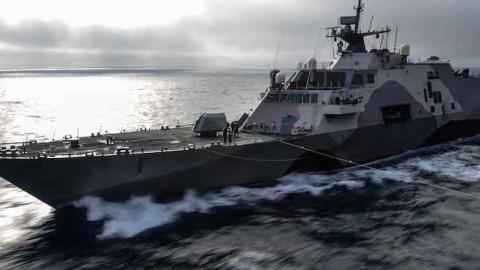President-Elect Trump intends to build a 350-ship Navy, increasing the size of the fleet by nearly a third. Because of the capital-intensive nature of maintaining the world’s dominant Navy, Presidential support is (and has always been) the critical element of growing the fleet, and the signals coming from the Trump team indicate that this is indeed a serious goal. That said, such growth is unlikely to occur without convincing the American people (and budget hawks on the Hill) of the strategic rationale for the increase, and without a rational and methodical plan that grows the fleet at a rate achievable with the existing industrial base. This second reality forms the basis for this piece.
There has been no timetable released for achieving the 350-ship number, but doing so within even two presidential terms would be a difficult proposition. Work with which I have been associated in the past leads me to believe that given the decline of the maritime industrial base (to include workforce considerations) growth of this degree is a 15-20-year undertaking, even under prioritized conditions. That said, significant progress can be made that provide a series of “wins” for the stakeholders involved in this path, to include the Navy, Capitol Hill, and the shipbuilding industrial base. One of the keys to that progress is the Small Surface Combatant (SSC).
The Navy has publicly stated that it has a requirement for 52 SSC, although the latest shipbuilding plan provides for only 40 because of Department of Defense directed alterations to the LCS program. This leaves a gap of 12 ships, although most observers believe ongoing fleet re-assessments will increase the total requirement to something closer to 70 SSC, a number which is not unrealistic within a 350-ship fleet.
To achieve a larger fleet of Small Surface Combatants in a realistic timeframe, the Navy should consider an evolutionary plan that leverages existing “hot” production lines while planning for a future ship that meets emerging requirements for a multi-mission frigate. The production lines under discussion are the two variants of the LCS, each of which have had significant growing pains in fleet introduction. The Navy has taken much criticism for this program, and a good deal of it is deserved. That said, ships are in serial production, unit costs have been stabilized, and recent changes to organization, training, and equipping should bring simplicity and stability to how the ships are employed.
None of this however, addresses the central criticisms of the ship, and that is its lack of both offensive and defensive punch. Much has been made of this, and addressing LCS’s relative lack of lethality was the “patient zero” in the development of the Navy’s recent “Distributed Lethality” concept. Building on these criticisms and leveraging the energy behind Distributed Lethality offers a path forward that implements Distributed Lethality in the SSC and increases its numbers steadily, but it will require a change to the Navy’s acquisition strategy. That path consists of the following:
* FY17 and FY 18 LCS bids should be required to address warfighting upgrades to the existing LCS hull, to include more robust anti-air warfare self-defense and the integration of a capable over-the-horizon surface to surface missile. Each yard would build two upgraded LCS in these two years. The Navy would reach pricing agreements with each yard for this variant of LCS to continue through FY25.
* Continue with the planned evolution of one of these designs to a Frigate, with that award coming in FY 19. The “Frigatized” version of would incorporate a larger crew, anti-submarine warfare upgrades, electronic warfare upgrades, area (30 nm) anti-air warfare capability and more lethal over the horizon missiles.
* The yard winning the “Frigate” for FY 19 would then switch only to building that ship, and would build two each year through FY25. The losing yard would continue to build the upgraded LCS at a rate of two each year through FY 25, at the pre-negotiated price.
* Plan to award an open-ocean Frigate in FY 26 in a competition open to all shipyards/design teams. This ship would be at least as capable as the Frigate variant of LCS, but would incorporate a more traditional drive train to achieve greater range.
* All LCS upgrades inserted into the FY 17/18 ships would be back fitted into the existing LCS fleet during regularly scheduled modernization periods.
What are the benefits of the above plan?
* The existing FY2017 Shipbuilding plan calls for the construction of 24 SSC from 2017-2036. This plan would result in the construction of 54 over the same period.
* The entire SSC segment of the Navy would become both more offensively lethal and defensively resilient.
* The Administration would make considerable progress toward its 350-ship goal in a way that works with the Navy’s existing concepts of operation.
* The future (2026) frigate would become a reality
* Both current SSC shipyards remain viable through 2025.
Building the 350-ship Navy will require a coherent strategic rationale, a good deal of money, and the political will to see it through. Finding a way to build the fleet that leverages existing production lines, delivers desired capability faster and in greater numbers, while managing the fragile maritime industrial base as a national strategic asset simply makes sense. This can be done, but only if the White House, the Pentagon, and Capitol Hill work together.



















